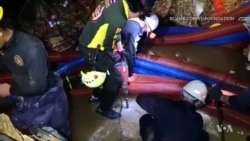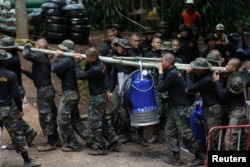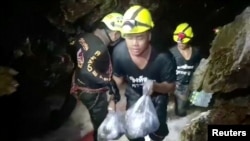There's a "limited amount of time" to get the 12 boys and their soccer coach out of a flooded cave in northern Thailand, according to authorities overseeing the rescue operation, citing worsening weather and a dwindling underground air supply.
The major operation inside and around Tham Luang Nang Non cave suffered its first death Friday when a former Thai navy SEAL passed out underwater and could not be revived. Authorities say Samarn Poonan had volunteered for the mission and died after running out of air while placing air tanks along the exit passage for the team members and their coach.
WATCH: Rescuers Battle Water, Oxygen Levels in Thai Cave as Diver Dies
"The environment inside the cave is challenging. When Sergeant Major Samarn was done placing air tanks inside, he was heading back," said Thai Navy SEAL Commander Arpakorn Yookongkaew.
His death, the first accident since the rescue operation began almost two weeks ago, highlights the perils of the operation to get the team out from the flooded cave the same way.
A senior army commander, Maj. Gen. Chalongchai Chaiyakam, says the most pressing mission now is to provide an air line to reach the team. Oxygen levels are decreasing because of the numbers of workers inside the cave. The oxygen line is tied to a telephone line to provide a channel of communication for the children, who are being looked after by four SEALs, including a medic.
The boys, aged 11 to 16, and their 25-year-old coach went exploring in the cave after a soccer game June 23. Monsoon flooding cut off their exit and prevented rescuers from finding them for almost 10 days, as the only way to reach them was by navigating dark and tight passageways filled with muddy water and strong currents.
Authorities have been racing to pump out water before more storms in the coming days raise the levels again. At this time, diving is the only possible method of escape, even though cave rescue experts warn it is extremely dangerous even for those with experience. Teams of rescuers also are exploring possible cracks or crevasses that might allow rescuers to break through and make a rescue.
The strategically placed air canisters allow divers to stay underwater for longer during what is about a five-hour trip to reach the stranded team.
The governor has said the 13 may not be extracted at the same time, depending on their condition. The boys are weak but for the most part physically healthy. They've practiced wearing diving masks and breathing, in preparation for the diving possibility.
Officials prefer to get the boys out as soon as possible because heavy rain is expected by Saturday.
They are hoping an upgraded draining effort can lower the water in an area where it is still at or near the ceiling. The idea is to get some headroom so the boys will not have to rely on scuba apparatus for a long stretch and can keep their heads above water.
Cave rescue experts have said it could be safest to simply supply the boys where they are, and wait for the flooding to subside. That could take months, however, given that Thailand's rainy season typically lasts through October. And without proper oxygen levels, staying put could also prove deadly.
Rescue operation
For rescuers, rain is one of two major risk factors, with the other being panic.
"It's pretty scary being in the dark," Alan Warild, captain of Australia's New South Wales Cave Rescue Squad, told VOA this week. "It's going to be muddy water. They won't be able to see anything. What will really be the hardest thing for the kids is just staying calm."
The cave system in Chiang Rai province, into which they disappeared, is well known for its depth and danger. To enter, the boys passed a sign warning people to stay out during the region's rainy season, which lasts from July to November. When the team entered the cave two weeks ago, the rainy season hadn't officially started.
But the rain had begun to fall. By the time they were found Monday, the youngsters and their coach had been trapped 2 kilometers into the damp, pitch-black belly of the mountain for more than a week. The narrow passages between the ledge on which they were found and the daylight outside are now filled with the cold, murky water. Reportedly, none of the boys can swim.
Experts say professional divers could guide the boys out, one by one. But it would require complicated diving skills that the boys do not possess — and after nearly two weeks of very little food and water, the five-hour journey to fresh air and sunlight will be even more challenging. A moment of panic in a narrow, flooded passage could spell disaster.
'Scene's going to change'
If more rain begins to fall, Warild said, "then the whole scene's going to change. A lot more water, a lot more current washing people around. Fighting strong currents, you use up a lot of air and a lot of energy."
Family and friends expressed relief when the boys were found, but video of the gaunt, disheveled lost youngsters released this week has only partially reassured their loved ones. A medical assessment Thursday by medics attending the boys in the cave concluded that neither the boys nor their coach is strong enough yet to attempt an exit.
Warild suggested a compromise that would buy the rescuers some time: Find a safe halfway point where the boys and rescue divers could take shelter if the cave refloods.
"There's no best option," Warild said.
















